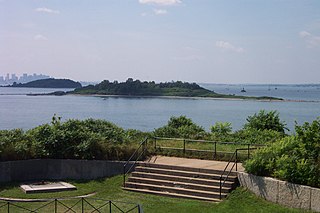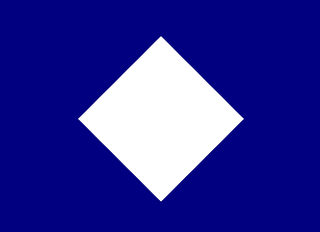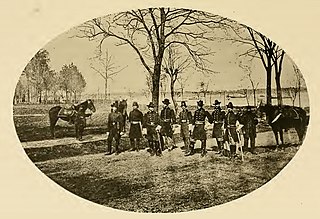
The 28th Massachusetts Infantry regiment was the second primarily Irish American volunteer infantry regiment recruited in Massachusetts for service in the American Civil War. The regiment's motto was Faugh a Ballagh

The 20th Massachusetts Volunteer Infantry, also known as the "Harvard Regiment", was a regiment of infantry in the American Civil War. The regiment was so nicknamed because the officers of the 20th were young Harvard graduates. In addition, some, but not all, of the private soldiers had attended Harvard. The 20th was organized at Camp Meigs in Readville, August 29 to September 4, 1861. After training they left Massachusetts for Washington, D. C., September 4. They would fight until the war's conclusion being mustered out on July 16 and discharged July 28, 1865. Fogel et al's Union Army Data urban sample suggests perhaps as many as two-thirds of the regiment's enlisted were immigrants with Irish immigrants making up half of the regiment's total.

The 9th Regiment Massachusetts Volunteer Infantry was a military unit from Boston, Massachusetts, USA, part of the Army of the Potomac during the American Civil War. It is also known as "The Fighting Ninth". It existed from 1861 to 1864 and participated in several key battles during the war. The unit is an Irish heritage unit, with many volunteers having been born in Ireland.
The 60th Regiment Massachusetts Volunteer Infantry was an infantry regiment that served in the Union Army during the American Civil War from 1864 to 1865.

The Unattached Companies of Massachusetts Volunteer Militia were units of infantry raised for the defenses of the eastern coast of Massachusetts during the American Civil War. Twenty-six companies were mustered into the Union Army during 1864-1865, several of them reorganizing for additional terms of service.

The 4th Massachusetts Volunteer Heavy Artillery Regiment was a unit that served in the Union Army during the latter part of the American Civil War. It was formed from former Unattached Companies of Heavy Artillery raised by Massachusetts to serve the state and for the defenses of Washington, D.C.
The 3rd Massachusetts Volunteer Heavy Artillery Regiment was a unit that served in the Union Army during the American Civil War. It was organized from already mustered unattached companies of heavy artillery raised for the defenses of the Massachusetts coast.
The 1st Battalion of Massachusetts Volunteer Heavy Artillery was a unit that served in the Union Army during the American Civil War. It was organized from several unattached companies of heavy artillery already raised and mustered into a three-year service for the defenses of the Massachusetts coast.
The 61st Regiment Massachusetts Volunteer Infantry was an infantry regiment raised for one year's service in the Union Army during the American Civil War from 1864 to 1865.

The 51st Regiment Massachusetts Volunteer Infantry was a regiment of infantry that served in the Union Army during the American Civil War. The regiment was assigned to Major General John G. Foster's Department of North Carolina, later designated as the XVIII Corps. While based in New Bern, North Carolina, the 51st Massachusetts took part in several expeditions involving numerous units from Foster's command and were engaged in the Battle of Kinston, the Battle of White Hall and the Battle of Goldsborough Bridge, among other engagements.

The 7th Regiment Massachusetts Volunteer Infantry was an infantry regiment in the Union army during the American Civil War. It was formed on June 15, 1861, in Taunton. Its original commander was Colonel Darius N. Couch who would eventually be promoted to command the II Corps of the Army of the Potomac and, after that, the Department of the Susquehanna.

The 16th Massachusetts was an infantry regiment that served in the Union Army during the American Civil War formed of volunteers from the Commonwealth of Massachusetts.

The 17th Massachusetts was an infantry regiment that served in the Union Army during the American Civil War.

45th Regiment Massachusetts Volunteer Infantry was an infantry regiment in the Union army during the American Civil War. The regiment trained at Camp Meigs in Readville, Massachusetts before traveling to North Carolina, where they fought in the Battle of Kinston in December 1862, and in skirmishes in and around New Bern, North Carolina in the spring of 1863. They suffered heavy casualties in battle and due to fever. In June they returned to Boston, where they patrolled the streets to quell any draft riots, and were discharged on July 21. They were commanded by Colonel Charles R. Codman (1829-1918).
The 3rd Massachusetts Volunteer Cavalry Regiment was a cavalry regiment that served in the Union Army during the American Civil War. It was organized by consolidating the 41st Massachusetts Mounted Infantry and the 2nd Battalion Massachusetts Cavalry on June 17, 1863. The regiment served with the XIX Corps, Army of the Gulf during the Red River Campaign in 1864. Its heaviest combat during this campaign took place during the Battle of Sabine Crossroads.

The 6th Massachusetts Battery was an artillery battery that served in the Union Army during the American Civil War. The unit was one of the Massachusetts regiments organized in response to President Abraham Lincoln's call on May 2, 1861 for volunteer troops to serve a term of three-years. The battery trained at Camp Chase in Lowell, Massachusetts. It was assigned to the Department of the Gulf under Major General Benjamin F. Butler and departed Boston by steamship on February 8, 1862. At that time, the unit comprised 145 men armed with two rifled and four smoothbore six-pounder field guns.

The 7th Massachusetts Battery was an artillery battery that served in the Union Army during the American Civil War. The original core of the unit was a company of infantry known as the Richardson Light Guard. The company initially served provost duty at Fortress Monroe, was eventually trained in light artillery drill, and reorganized on March 17, 1862 as the 7th Massachusetts Battery.

The 11th Massachusetts Battery was an artillery battery that served in the Union Army during the American Civil War. It was formed in response to President Abraham Lincoln's August 1862 call for 300,000 men to serve for nine months. Several months after completing their first term of service, the battery was reorganized for a second term of three years. It was recruited by Captain Edward J. Jones of Boston and consisted almost entirely of men from that city. The battery served a largely uneventful first term as garrison troops mostly in Centreville, Virginia. During their second term they were involved in heavy combat being part of the Army of the Potomac during Lieutenant General Ulysses S. Grant's Overland Campaign.

The 13th Massachusetts Battery was an artillery battery that served in the Union Army during the American Civil War. The unit was organized at Camp Meigs near Boston during the fall of 1862. Its members were mustered in at various times over the fall and the officers mustered into federal service on November 3, 1862. It was assigned to the Department of the Gulf commanded by Major General Nathaniel P. Banks and departed Massachusetts by steamship on January 20, 1863.

The 14th Massachusetts Battery was an artillery battery that served in the Union Army during the American Civil War. It was organized during the winter of 1863 - 1864 at Camp Meigs just outside of Boston. It was commanded by Captain Joseph W. B. Wright of Boston and consisted mostly of men from that city. The enlisted men were mustered into federal service on February 27, 1864. They departed Massachusetts on April 4, 1864, arrived at Annapolis and then moved to Camp Marshall in Washington, D.C. On April 22 and 24 they were outfitted with field guns and horses but had virtually no time to train in light artillery tactics before they were assigned to the IX Corps of the Army of the Potomac and joined Lieutenant General Ulysses S. Grant's Overland Campaign.











